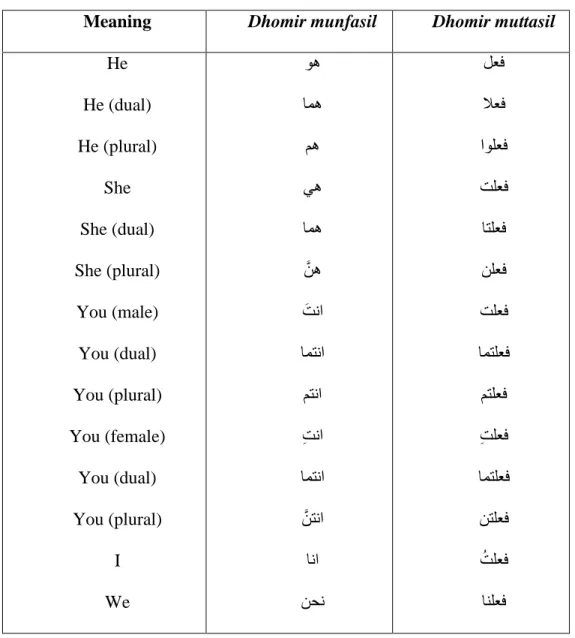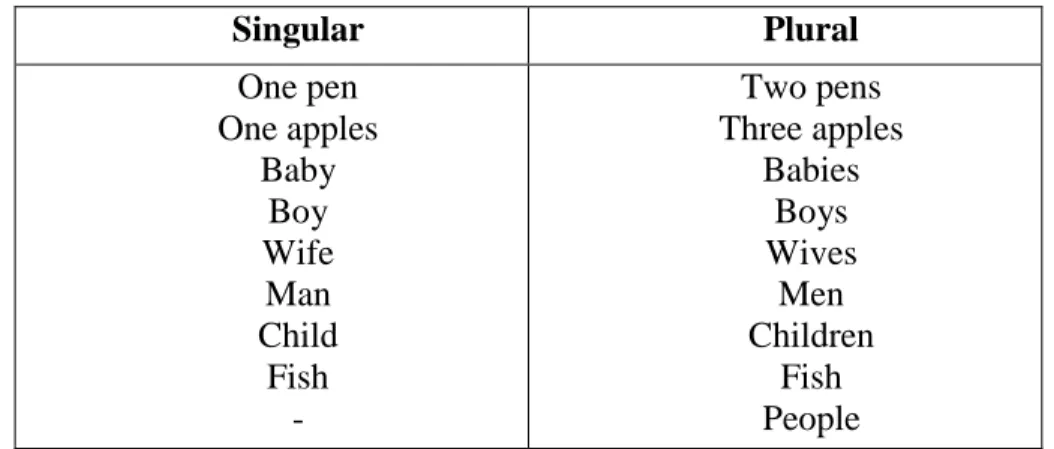The purpose of the research is to identify similarities and differences between English and Arabic verbal sentences. English and Arabic language as an international language must learn for everyone, especially for Muslims. The research result found that there are similarities in both English and Arabic that have verb form.
Thanks and all glory to My Allah for all Your blessings and Your favor which You have given with all Your Might, the researcher can complete the undergraduate thesis. I am aware that this thesis would not have been possible without the help and support of many helpful individuals. First of all, my deepest gratitude would be addressed to my beloved parents, for their understanding and support to complete my undergraduate thesis soon, and they always pray for me to be a successful man one day (Aamiin).
Dedi Irwansyah, M.Hum and Mr Andianto, M.Pd within their activities, they were still willing to read the undergraduate thesis. The third, thanks to all my lecturers in the English Education Department of IAIN Metro who always give me knowledge and information. Next, all the staff of the English Education Department of IAIN Metro who helped the researcher in the processing of administration.
As a human being, the researcher realized that there are some weaknesses in this university thesis.
RESULT AND DISCUSSION
INTRODUCTION INTRODUCTION
Problem Formulation
Objective and Benefit of Study The objective of this study is
Prior Research
There are some aspects to make English interrogative sentences such as auxiliary verb, modal verb, to be. In this research, we explained that there is some regulation when we use countable and uncountable nouns. The results of this research showed that English articles are more simple than Indonesian articles, specifically in singular nouns.2.
The aim of this research is to check the hypothesis of simple sentence structures between the English and Arabic standard language. The researcher uses Lado's procedures to construct the grammatical system of two languages and uses SPSS to show whether the results are true or not. This contrastive analysis hypothesis can be useful for teaching and learning purposes, translations and curriculum design purposes.3.
1Mashlihatul Umami, “A Contrastive Analysis of Interrogative Sentences in English and Indonesian”, Jurnal Dimensi Pendidikan dan Pembelajaran Vol. The difference of three studies is called that the first study is interrogative sentence study, the second is noun study and the last general sentence pattern.
Research Method
- Definition of Contrastive Analysis
- Procedures of Contrastive Analysis
It means data that is directly related to the research object.6 The main data source of this research is the Oxford guide to English grammar written by John Eastwood. The reliability to use is the accuracy, that is, the accuracy between the research and the literature study. The descriptive analysis method is an attempt to collect and compile a data, then an analysis of the data is done.
Descriptive analysis of the collected data is in the form of words, images and not numbers. Content analysis in the study was conducted to reveal the content of a book that described the situation of the author and his society at the time the book was written. Contrastive analysis is the systematic comparison of two or more languages, with the aim of describing similarities and differences.10 Contrastive analysis is commonly used for educational or practical purposes.
By discovering comparisons between some of these languages, a student will more easily understand the structure of the language. Contrastive analysis is the systematic study of a language pair with a view to identifying their structural differences and similarities.11 This method was originally used to determine the language genealogies. Contrastive analysis was used in the field of second language acquisition in the 1960s as a method to explain why some aspects of the target language were more difficult to understand than others.
This method contrasts the system of language, syntax, phonology, grammar and lexicon of the second language system as a result of predicting difficulties second language learners would have in learning the target language. Based on the above definition, the writer concludes that contrastive analysis is a systematic comparison between two or more languages used for pedagogical purposes. Contrastive analysis as a predictive technique, it means that by looking at the structure of two or more language systems, we can predict the difficulties of the language learner.
In the first step in contrastive analysis, the researcher has to choose two languages and then write the description about them. 13 Mohammad Hamad Al-khresheh, “A Review Study of Contrastive Analysis Theory,” Journal of Advances of Humanities and Social Sciences 2, no. So before comparing the selected category of the two languages, make sure that the description is clear.
The Concept of English Sentences 1. Definition of English Sentences
- Kinds of English Sentences
- Verbal sentences
There is a difference between an active and a passive sentence, in an active sentence the subject is at the beginning, but in a passive sentence the subject changes place with the object. The predicate contains a verb.17 A verb can be used with a subject in the base of a clause. Today I saw them playing with Angga .. f) Gerund: a form of the verb ending –ing used as a noun as the subject or object of a sentence.
Adverbs have four types, there are adverb of manner, adverb of time, adverb of place and adverb of frequency. Verbal sentences must also have at least two components, they must have verb and verb's subject. Verb or predicate in verbal sentences used to identify what the subject is doing.19 The position of verb follows the subject.
The object is a noun or a pronoun comes after the verb.22 There are several forms of the object such as noun, pronoun, infinitive and gerund. I need to know about fi'il, not every fi'il is a verb, but every verb is a fi'il. Fi'il muta'adiy is a verb that has an object to complete the meaning of the sentence.
Fi'il maḍi, initial letter fi'il with harakat dhommah, and letter before the end with harakat kasrah. 2.) Fi'il muḍori', initial letter fi'il with harakat dhommah, and letter before the end with harakat fathah. Subject in Arabic called fā'il.26 In active sense subject as a f ā'il, while in passive sense it is as a na'ibul fā'il.
Fā'il fi na'ibul fa'il bifa maqaa ta'uu kan danda'an yoo ta'u, gocha waliin maḍī (kan darbe), muḍore' (kan ammaa), yookaan amar (dirqama) keessatti walqabsiisuu qabu.
Description of Data
Ilmu Nahwu Untuk Pemula yang ditulis oleh Abu Razin dan Ummu Razin pada tahun 2014, buku ini tidak diterbitkan dan itu adalah buku Pustaka BISA (Belajar Islam dan Bahasa Arab).
The Similarities Between English and Arabic Verbal Sentences
According to (Anne Seaton, 2007) in English grammar the noun can be singular and plural, to make the plural form of most nouns add –s or –es at the end of the term and condition. According to (Abu Razin, 2014) the Arabic name or isim according to the quantity divided into three types.
The Differences Between English and Arabic Verbal Sentences
Baby Boy Woman Man Child. Huda, 2012) Arabic verbal sentence structure includes verb and subject, where it starts verb and then follows the subject. Based on (Ronald Carter, 2006) In English there is not passive verb and active verb, but there is active and passive sentence. While the passive sentences when the subject has an action done by someone or something to it.
The verb used in passive speech is always V3 or perfect participle, while the one to be used is in accordance with the sentence pattern. The arrangement is the object of the sentence placed in the position of the subject and then added to be and followed by the word v3 and also the subject is placed in the position of the object. There are two kinds of pronouns in Arabic grammar, connected with verb and separated with verb.
Based on (Abu Razin, 2014) pronoun divided into two types, there are dhomir munfasil and dhomir muttasil. Dhomir munfasil or a pronoun separated from a verb, dhomir muttasil is a pronoun connected to a verb. Dhomir munfasil, divided into 14, is 8 for the pronoun of the first and second persons, which combine with the verb and can be understood without mentioning the subject, but the pronoun of the third person must mention the subject.
According to (Abu Razin, 2014) in an Arabic structure and grammar, the subject should be in the rafa state. Similarities Between English and Arabic Verb Sentences English Verb Sentences Arabic Verb Sentences Have the verb forms, present. After analyzing the data of English and Arabic verbal sentences based on the basic word order and pattern, the researcher concludes as follows.
Between English and Arabic verbal sentences have some similarities, as in Arabic tenses have verb form as in English structure, that is past form and present form. Some differences are the basic word order, both English and Arabic are opposite, where in English is SVO, while in Arabic is VSO. In Arabic grammar verb must be in rafa' state and the object must be in nasab state.

Suggestion
The last differences is an Arabic passive verb, where the rules for changing active verb to passive are modified with harakat. The researcher hopes that this writing can help the linguist and the learner who is learning English and Arabic.
